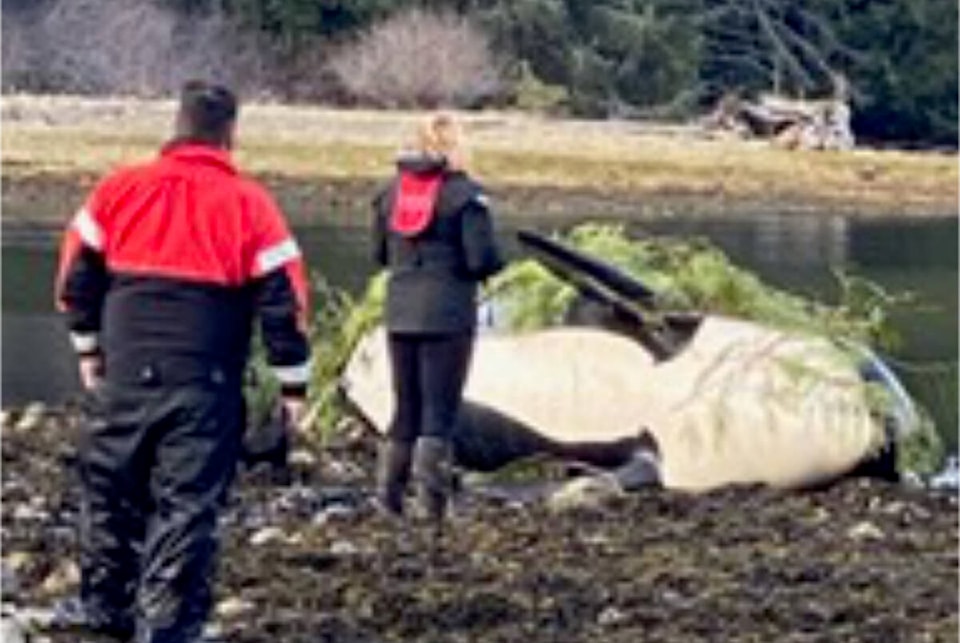An orca that died after being beached near Zeballos on Vancouver Island last weekend had been pregnant, according to a necropsy performed on March 25.
On the morning of March 23, a road maintenance crew spotted a killer whale stranded on a gravel bar in the lagoon of Little Espinoza Inlet just down the road from the village of Ehatis, near Zeballos. Fishery officers from the DFO Port Hardy Detachment trained in marine mammal rescues immediately departed for Zeballos with re-floatation pontoons and specialized equipment. Further DFO response team members flew into the area to lead the response in collaboration with First Nations and the community while C&P (Conservation and Protection) fishery officers from the other area Detachments were deployed. Despite the work of Nuchatlaht and Ehattesaht First Nations, who are trained in marine mammal response and DFO staff, the whale died.
On Sunday, fishery officers were able to secure the Biggs Killer Whale and move her at high tide from inside the lagoon where she had been stranded to a nearby beach. There, Ministry of Agriculture and Lands veterinarian Dr. Stephen Raverty led a necropsy on the whale. During that examination, it was discovered that the whale had been pregnant.
“The Ehattesaht First Nation conducted ceremonies for the unborn animal and made heroic efforts to keep the whale cool and try to shepherd her out of the lagoon before she unfortunately died at approximately 10:45 a.m. Saturday, March 23, 2024,” a release from DFO says.
“They are such magnificent animals and I have been with them on the water almost my whole life. But they are always at a bit of distance,” says a statement from Ehattesaht chief Simon John and council “Being so close and touching her seeing her calf and being so helpless is hard to describe. Its really upsetting and we had so many from the local community there to help but when you have a sad ending it really is hard on everyone who was there.
“It is really important to remember that we are connected to these animals and I believe these events are really difficult but really important. Everyone is to a certain extent and we have to take a bit of time to think what it means to us all.”
A statement from DFO says that it is unclear why the whale was in the lagoon when she became stranded, and definitive results from the necropsy may take several weeks.
The whale’s living calf had followed her into the lagoon, and work has been ongoing to reunite the calf with her pod.
“For the next few days we will be concentrating on the baby and we will be giving her a name. kwiisaḥiʔis (kwee-sa- hay-is) (Brave Little Hunter) But we will have to think about her safety and limiting all the human interaction so we will be closing the road for most of the day with local traffic only passing,” John’s statement says. “I know people will want to visit and help but really DFO and ourselves need some time to formulate a plan and we need to think about the little one.”
The responders on site attempted a playback of recorded pod members’ calls on Monday at high tide to see if this would entice the calf out of the lagoon. This is a method that has had some success in other incidents in the past. A C&P patrol vessel and area fishery officers supported this pod call effort using the vessel as a platform for the deployment of lubelle speakers. However, they were not successful.
The Ehattesaht have also suspended their forestry operations for today, Tuesday, March 26, and have provided their support helicopter to see if the whale pod can be spotted.
“The tide window is closing over the next few days which may not allow for on-water efforts during that time,” the DFO statement says.
Staff is onsite on a rotating basis, and DFO is in talks with the Ehattesaht and Nuchatlaht First Nations on plans moving forward.
RELATED:



